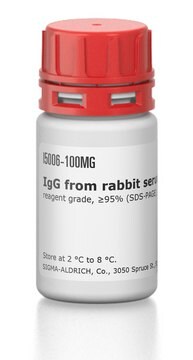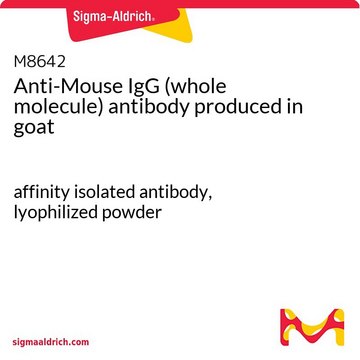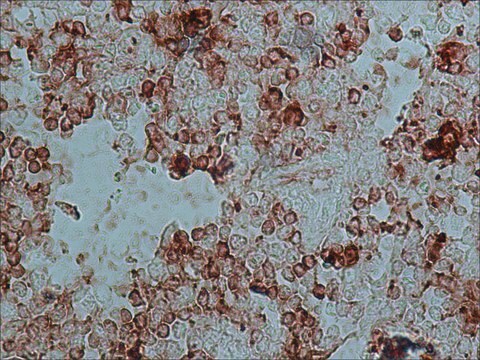G7402
Anti-Rabbit IgG (whole molecule)–Gold antibody produced in goat
affinity isolated antibody, aqueous glycerol suspension, 10 nm (colloidal gold)
Sign Into View Organizational & Contract Pricing
All Photos(1)
About This Item
Recommended Products
biological source
goat
Quality Level
conjugate
gold conjugate
antibody form
affinity isolated antibody
antibody product type
secondary antibodies
clone
polyclonal
form
aqueous glycerol suspension
technique(s)
dot blot: suitable
western blot: suitable
particle size
10 nm (colloidal gold)
storage temp.
2-8°C
target post-translational modification
unmodified
Looking for similar products? Visit Product Comparison Guide
General description
IgG antibody plays a crucial role in humoral immune responses such as complement activation, phagocytosis, placental transport and cell surface-receptor binding. Anti-rabbit IgG (whole molecule)-gold antibody can be used as secondary antibody (diluted 1:50 in 0.01 M PBS containing 1% BSA and 5% NGS) in EM immunolabeling of GABA and glutamate by postembedding procedure. It can also be used in a modified dot blot assay to determine binding activity. Goat anti-rabbit IgG (whole molecule)-gold antibody reacts specifically with all goat immunoglobulins.
Immunoglobulins (Igs) are glycoprotein antibodies that modulate several immune responses. Rabbit IgGs against target proteins are often used as primary antibodies in various research applications. Thus, secondary anti-rabbit IgGs can be useful tools for the analysis of target proteins
Anti-Rabbit IgG (whole molecule)-Gold antibody is specific for rabbit IgG.
Anti-Rabbit IgG (whole molecule)-Gold antibody is specific for rabbit IgG.
Immunogen
Rabbit IgG purified from normal rabbit serum.
Application
Anti-rabbit IgG (whole molecule)-gold antibody (diluted 1: 15) can be used in immunoelectron microscopy. It can also be used in western blotting.
Applications in which this antibody has been used successfully, and the associated peer-reviewed papers, are given below.
Immuno-electron microscopy (1 paper)
Immunohistochemistry (1 paper)
Immuno-electron microscopy (1 paper)
Immunohistochemistry (1 paper)
Physical form
Colloidal suspension in Tris buffered saline, pH 8.2, with 30% glycerol (v/v), 1% bovine serum albumin (w/v), and 15 mM sodium azide.
Disclaimer
Unless otherwise stated in our catalog or other company documentation accompanying the product(s), our products are intended for research use only and are not to be used for any other purpose, which includes but is not limited to, unauthorized commercial uses, in vitro diagnostic uses, ex vivo or in vivo therapeutic uses or any type of consumption or application to humans or animals.
Not finding the right product?
Try our Product Selector Tool.
Storage Class Code
10 - Combustible liquids
WGK
WGK 3
Flash Point(F)
Not applicable
Flash Point(C)
Not applicable
Personal Protective Equipment
dust mask type N95 (US), Eyeshields, Gloves
Choose from one of the most recent versions:
Already Own This Product?
Find documentation for the products that you have recently purchased in the Document Library.
Customers Also Viewed
Ignaz Wessler et al.
PloS one, 11(6), e0156886-e0156886 (2016-06-11)
The worldwide use of neonicotinoid pesticides has caused concern on account of their involvement in the decline of bee populations, which are key pollinators in most ecosystems. Here we describe a role of non-neuronal acetylcholine (ACh) for breeding of Apis
S Sinnarajah et al.
FEBS letters, 426(3), 377-380 (1998-05-26)
The odorant-induced accumulation of cAMP can be inhibited by antibodies directed against G alpha s/olf. In contrast, antibodies raised against G alpha i-subunits caused a strong enhancement of the odorant-induced cAMP accumulation. Western blotting and immunoelectron microscopy revealed the presence
Andrea González et al.
The American journal of tropical medicine and hygiene, 92(5), 887-897 (2015-03-12)
Trypanosoma cruzi calreticulin (TcCRT), a 47-kDa chaperone, translocates from the endoplasmic reticulum to the area of flagellum emergence. There, it binds to complement components C1 and mannan-binding lectin (MBL), thus acting as a main virulence factor, and inhibits the classical
Jiongjiong Chen et al.
Proceedings of the National Academy of Sciences of the United States of America, 105(32), 11436-11441 (2008-08-06)
Hybrid sterility is a major form of postzygotic reproductive isolation. Although reproductive isolation has been a key issue in evolutionary biology for many decades in a wide range of organisms, only very recently a few genes for reproductive isolation were
Vladimir Varga et al.
Proceedings of the National Academy of Sciences of the United States of America, 114(32), E6546-E6555 (2017-07-21)
The distal end of the eukaryotic flagellum/cilium is important for axonemal growth and signaling and has distinct biomechanical properties. Specific flagellum tip structures exist, yet their composition, dynamics, and functions are largely unknown. We used biochemical approaches to identify seven
Our team of scientists has experience in all areas of research including Life Science, Material Science, Chemical Synthesis, Chromatography, Analytical and many others.
Contact Technical Service














